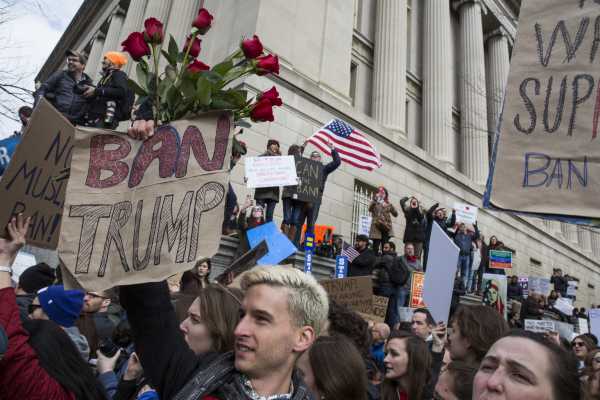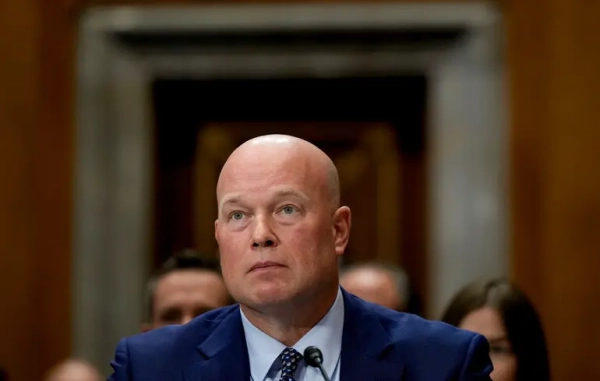
President Donald Trump is reportedly considering expanding his travel ban to citizens of seven additional countries — Belarus, Myanmar, Eritrea, Kyrgyzstan, Nigeria, Sudan, and Tanzania — according to Politico.
The ban would prevent most citizens of those countries from coming to the US, with exceptions for refugees and those who already have US green cards or visas.
The Trump administration sometimes floats plans, especially related to immigration, without ever formally acting on them. But expanding the travel ban has long been rumored to be on the president’s agenda, and Trump told the Wall Street Journal on Tuesday that he would make an announcement by the end of the month, while also refusing to confirm which countries would be affected.
The announcement could happen as soon as Monday, Politico reported, though the list of countries subject to the ban could still change before then.
The expansion of the ban would likely hit Nigeria, the largest African country by population, the hardest of any of the countries under consideration. In 2018, the US granted Nigerians almost 14,000 green cards and 222,000 temporary visas. Citizens from other countries on the list, by comparison, were granted a combined total of fewer than 6,000 green cards and 28,000 temporary visas.
The Supreme Court affirmed that Trump has broad authority to restrict immigration where national security demands it. But it’s not clear whether any of these countries pose a direct threat to the US, since many are dealing with various forms of domestic conflict, including homegrown terrorism.
The costs to those in the US would be grave: Expanding the travel ban would forcibly separate individuals who are currently living in the US from their families, as well as discourage students from coming to the US for their studies, since they won’t have the option to remain in the country permanently. The consequences of an expanded ban might have serious repercussions globally, too: It could stymie multinational businesses and reverse recent, albeit tenuous, strides in diplomatic relations with the affected countries.
How the existing ban works
Under the first version of the ban, unveiled in January 2017, citizens of seven majority-Muslim countries, including those who held US green cards and dual US citizenship, were held for questioning for many hours at airports across the country and denied entry to the US. A de facto “Muslim ban,” the policy appeared to be the fruition of Trump’s call on the campaign trail for a “total and complete shutdown” of Muslims entering the US and sparked widespread protests throughout the country.
After courts blocked the first version of the ban just days after it went into effect, the administration went back to the drawing board, engaging multiple agencies to identify countries that pose threats to US national security and broadening the scope of the ban beyond majority-Muslim countries. The agencies’ findings have never been made public — meaning the nature of those threats remains unclear — and dozens of former intelligence officials have argued that the ban does nothing to improve US national security.
But the administration has broadly cited terrorist activity, a failure of the countries to properly document their own travelers, and insufficient efforts to cooperate and share information with US authorities as justification for the ban.
The US Supreme Court accepted the administration’s rationale in June 2018 when it upheld the ban in a major victory for Trump. The Court found that it was within the president’s power to “suspend the entry” of anyone who would be “detrimental to the interests of the United States.”
The version of the ban now in place, which is the third Trump has issued, places restrictions on citizens of Iran, Libya, Somalia, Syria, Yemen, Venezuela, and North Korea who seek to enter the US. (Chad was taken off the list of countries subject to the ban last April after it met the Trump administration’s demands to share information with US authorities that could aid in efforts to vet foreigners.)
The ban is mostly enforced abroad at US consulates and embassies that are denying visas to those affected and preventing them from getting on a plane in the first place.
People with existing visas or green cards, dual US citizens, and refugees seeking to come to the US are not affected. (However, during his time in office Trump has separately slashed the overall number of refugees who can resettle in the US annually, from 110,000 to 18,000.)
Beyond that, the restrictions on travel differ by country. Citizens of all seven countries are barred from obtaining green cards and entering a visa lottery program.
Syrians and North Koreans cannot enter the US at all, though the number of travelers coming from North Korea is negligible. Iranians can’t obtain visas unless they’re students, but since students have no chance of remaining in the US after graduation, fewer of them have decided to come. Somalians can still obtain temporary visas, including student visas and H-1B skilled worker visas.
Those from Yemen and Libya, as well as certain Venezuelan government officials and their families, can’t obtain temporary visas as athletes, business visitors, tourists, or those seeking medical treatment in the US.
Citizens of any one of the countries can qualify for a waiver that would grant them entry to the US if, for example, they need urgent medical care or are trying to reunite with their immediate family in the US, but those waivers are exceedingly difficult to obtain.
The restrictions have hit Iran, Libya, Somalia, Syria, and Yemen the hardest: The number of visas granted to citizens of those countries fell by 80 percent from 2016 to 2018.
What we know about the countries under consideration
Expanding the ban to the seven countries under consideration would affect hundreds of thousands of foreigners who apply for visas and green cards in the US every year.
Many of the countries that may be added to the travel ban have committed human rights violations and are ridden with conflict, sometimes in the form of terrorist activity. Some have recently increased their cooperation with the US and Europe, but it’s not clear whether their information-sharing and security standards fall short of the Trump administration’s baseline.
Nigeria has partnered with the US in counterterrorism operations against Boko Haram, one of Africa’s largest Islamic militant groups, which has killed almost 38,000 people since 2011 and displaced another 2.5 million. A large Nigerian diaspora has since settled in the US.
The decision to include Belarus and Kyrgyzstan, the latter of which is about 85 percent Muslim, came as a surprise to some experts, given that the ex-Soviet nations have made efforts to distance themselves from Russia.
Belarus recently reopened diplomatic relations with the US after a decade-long hiatus, and Kyrgyzstan reached a new cooperative agreement last year, bringing it closer to the EU. But human rights abuses, including crackdowns on the press and political figures, nevertheless remain a problem in both countries.
US relations with Sudan have also improved as of late, with State Department officials suggesting in November that it would be removed from a list of state sponsors of terrorism. A civilian government has replaced former Sudanese President Omar al-Bashir’s Islamist government, which was accused of sponsoring attacks on civilians and forcibly displacing millions as part of its attempts to stamp out rebel forces.
The State Department, however, has voiced concerns about Tanzania’s “shrinking democratic space,” as its repression of the media, human rights advocates, and political opposition has ramped up since 2015.
The US currently accepts relatively high numbers of refugees from several of the countries being considered for the travel ban’s expansion.
Of the 30,000 refugees who resettled in the US from October 2018 to October 2019, 4,932 came from Myanmar, which has engaged in a large-scale ethnic cleansing campaign against Rohingya Muslims since 2017, forcing more than 671,000 to flee to Bangladesh. The US also accepted 1,757 citizens from Eritrea, where a decades-long totalitarian regime has driven out about 480,000 people. Refugee admissions aren’t expected to stop under the new ban.
Sourse: vox.com






